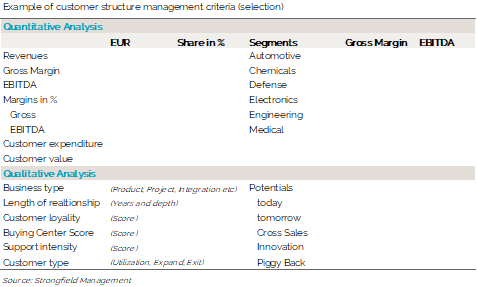Customer Structure Management – A Necessary Success Factor in Crisis Situations or Times of Strong Market Change?

One of the core aspects of corporate management is the question “Which approaches lead to sustainable success?” Starting with customer management and the sales structure is not only logical, but also consistent when thinking from the end.
Irrespective of strategic goals and the company-specific cost and competitive advantages in value creation, technology, corporate culture, organization and (digital) processes, the quality and composition of the customer structure and its development are elementary for the long-term and economic success of a company. Customers pay for products and services if they receive an advantage or value from them. If the price for a service is higher than the cost of production because it is particularly good or offers significant added value, then the company earns money and can even grow.
Accordingly, it is important to have the “right” customer and market structure that requires and appreciates these services. Companies that develop their customer structure systematically, value-oriented and consistently should be more successful than those that do not or do so only insufficiently.
But how can this be achieved? The answer: Through value-added customer structure management.
This method starts with the evaluation of existing customer relationships, its present or potential value but also new customers based on defined and weighted factors in the context of added value for both sides. In other words, a comprehensive overall picture of a customer is drawn regarding both its operational and strategic value, and price, cost and value differentials are identified. In this process, key account management and corporate management must work closely together and take the lead.

Existing and applied customer structure management leads to a plausible, transparent overall picture of a customer and thus to a better basis for decision-making and argumentation, even in the case of individual measures that need to be implemented, such as price increases, which in many cases are currently the only alternative from a business point of view. But other aspects are also derived, which in turn provide impetus for R&D of new products and services.

As part of the customer evaluation, customer relationships are therefore evaluated in a structured manner by management according to clear criteria, both quantitatively and qualitatively, and specific steps and measures are developed together with key account management for each market segment, customer type and account. This can result in the steps and time horizon in which price increases are to be implemented on a customer-specific basis, or in the need for reallocations, either in the product or in the market. This is an indispensable success factor, especially in times of business crisis or major market changes, as we are currently experiencing.

Outside help is often necessary here, since methodology, criteria, systematics, and the application and consistent implementation of active customer structure management are often lost in day-to-day business or there are questions of understanding.
Insights from outside supported by active coaching with mentoring in customer structure management, key accounting and innovation management can help to sustainably align and transform companies for new growth and increased profitability.

Alexander Tschackert, LL.M.
Partner, Strongfiled Management
Strongfield supported State-owned Oman Aluminium Rolling Company (OARC), in a year-long probe by the US Department of Commerce
Silvio Stockmann advised the CEO on cost accounting, forensic data, evidencing, market intel and analytics Strongfield supported State-owned Oman Aluminium Rolling Company (OARC), in a year-long probe by the US Department of Commerce into allegations that the sultanate unfairly capitalized on OARC’s operations in a US countervailing duty investigation. As an advisor to the CEO,…
Losberger de Boer successful restructuring
Silvio Stockmann completes his assignment as CRO of the Gruppe by Juli 2021 The German-Dutch supplier of large tents and modular space from Bad Rappenau in Baden-Württemberg, which was threatened with insolvency at times, has been successfully restructured. Silvio Stockmann, who led the company as CRO in its operational turnaround with the management of the…
News, delivered right to your inbox.
Sign up to receive insights, event information and company news.